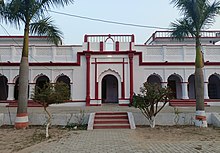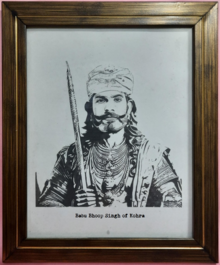Bandhalgoti
| Bandhalgoti | |
|---|---|
 Flag | |
| Parent house | Kachhwaha |
| Country | Amethi Kohra |
| Founded | 1358 |
| Founder | Raja Sut Sah |
| Current head | Sanjay Singh of Amethi Raghvendra Pratap Singh of Kohra |
| Final ruler | Raja Bhagwan Baksh Singh of Amethi Babu Beni Bahadur Singh of Kohra |
| Titles | Raja of Amethi Babu of Kohra |
| Style(s) | Raja Babu |
Bandhalgoti is a clan of Rajputs mainly found in Uttar Pradesh.They are an off-shoot of Kachhwaha dynasty.[1][2][3] Bandhalgoti Rajputs ruled a number of estates including Amethi, Kohra and Shahgarh etc. which lie in present-day Uttar Pradesh.[4]


History
The Bandhalgotís, Badhilgotís, or Banjhilgotís, according to their own account, are Súrajbans by origin, and belong to the particular branch of the clan now represented by the Rajah of Jaipur. About nine hundred years ago, Sudah Rai, a scion of that illustrious house, leaving his home in Narwargarh, set out on a pilgrimage to the holy city of Ayodhya. His route lay across the Amethi parganah, where, near the present village of Raipur, half overgrown with tangled weeds and briars, a deserted and dilapidated shrine of Debf suddenly presented itself to his view. The Bhars then held sway, and few vestiges anywhere remained of Hindú places of worship, so the pious pilgrim resolved to tarry awhile near the one accident had brought him to. Having performed his devotions, he lay down to rest, and in his slumbers saw a vision of the goddess of the fane, who disclosed to him a lofty destiny ordained for him and his descendants; they were to become hereditary lords of the territory in which he was then a temporary sojourner. Prepared to further to his utmost the fulfilment of so interesting a prophecy he determined to abide thenceforth in his future domains; and, relinquishing his uncompleted pilgrimage, entered into the service of the Bhar chieftain. His innate worth soon manifested itself in many ways, and secured his elevation to the post of minister. His Bhar master now designed, as a crowning act of favour, to bestow his daughter upon him in marriage; but a Súrajbans, though he might condescend to serve a barbarian, might not sully his proud lineage by a mésalliance, and Sudah Rai contemptuously refused the proffered honor. The Bhar chief, in offended pride, at once deprived him of his office, and he returned to Narwargarh. But his mind was ever occupied with thoughts of the promised land, and by way of assisting the tardy workings of fate, he collected a picked band of followers and marched against Amethi. The Bhars were defeated with a great slaughter, and the Súrajbans occupied their territory. Sudah Rai established a fort on the spot where he had seen the prophetic vision; and included therein the ruined shrine, in grateful commemoration of the divine interposition in his fortunes which had occurred there.[5]
After the lapse of a few generations, the line of Sudah Rai threatened to become extinct, for Mándhátá Singh, sixth in descent from him, remained childless in his old age. In the village of Kannú, however, resided Kanak Mun, one of those mighty saints whose irresistible piety carried everything before it. To him Mándhátá Singh poured out his tale of woe, and humbly invoked his aid; nor in vain, for by dint of the saint's prayers and austerities the threatened calamity was averted. A son was born to Mándhátá Singh, and he was at first called Sút Sáh, but, when he was taken to be presented to the saint, the latter suggested that his name should be changed to one more expressive of the peculiar circumstances of his birth, and he was therefore renamed Bandhú. His descendants, to mark their recognition of the important place he holds in their history, have since called themselves Bandhúgotís, the children of Bandhú, or popularly Bandhalgotis.[5]
Notable people
- Babu Himmat Sah, Ruler of Kohra (estate)[1]
- Babu Bhoop Singh, Ruler of Kohra (estate) and Leader of Indian Rebellion of 1857[6]
- Ravindra Pratap Singh, Former MP and Former MLA
- Sanjaya Sinh, Former MP and Former Cabinet Minister
- Rakesh Pratap Singh, MLA
- Deepak Singh, Former MLC
See also
References
- ^ a b Govt. Press United Provinces, Allahabad (1903). Sultanpur: A Gazetteer, Being Volume Xlvi Of The District Gazetteers Of The United Provinces Of Agra And Oudh. pp. 112–166.
- ^ Lethbridge, Sir Roper (2005). The Golden Book of India: A Genealogical and Biographical Dictionary of the Ruling Princes, Chiefs, Nobles, and Other Personages, Titled Or Decorated of the Indian Empire. Aakar Books. p. 294. ISBN 978-81-87879-54-1.
- ^ Lethbridge, Sir Roper (1985). Prominent Indians of Victorian Age: A Biographical Dictionary. Archives Rare Prints. p. 294.
- ^ Gazetteer of the Province of Oudh. Oudh Government Press. 1877. pp. 44–45, 46.
- ^ a b Millett, A. F. (1873). Report on the settlement of the land revenue of the Sultánpur district. [With] Accompaniments.
- ^ Mukherjee, Rudrangshu (2002). Awadh in Revolt, 1857-1858: A Study of Popular Resistance. Orient Blackswan. pp. 179–195. ISBN 978-81-7824-027-5.
